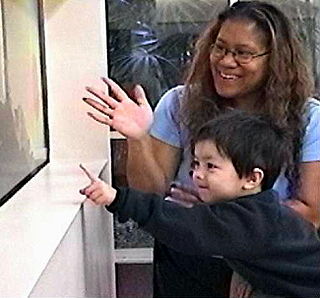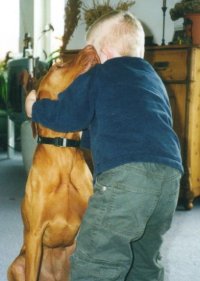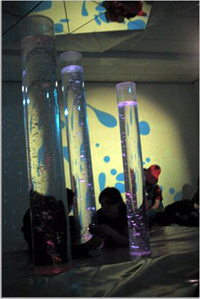
Physical therapy (PT), also known as physiotherapy, is a healthcare profession, as well as the care provided by physical therapists who promote, maintain, or restore health through patient education, physical intervention, disease prevention, and health promotion. Physical therapist is the term used for such professionals in the United States, and physiotherapist is the term used in many other countries.
Occupational therapists (OTs) are health care professionals specializing in occupational therapy and occupational science. OTs and occupational therapy assistants (OTAs) use scientific bases and a holistic perspective to promote a person's ability to fulfill their daily routines and roles. OTs have training in the physical, psychological, and social aspects of human functioning deriving from an education grounded in anatomical and physiological concepts, and psychological perspectives. They enable individuals across the lifespan by optimizing their abilities to perform activities that are meaningful to them ("occupations"). Human occupations include activities of daily living, work/vocation, play, education, leisure, rest and sleep, and social participation.

Music therapy, an allied health profession, "is the clinical and evidence-based use of music interventions to accomplish individualized goals within a therapeutic relationship by a credentialed professional who has completed an approved music therapy program." It is also a vocation, involving a deep commitment to music and the desire to use it as a medium to help others. Although music therapy has only been established as a profession relatively recently, the connection between music and therapy is not new.

Occupational therapy (OT) is a healthcare profession that involves the use of assessment, intervention, consultation, and coaching to develop, recover, or maintain meaningful occupations of individuals, groups, or communities. The field of OT consists of health care practitioners trained and educated to support mental health and physical performance. Occupational therapists specialize in teaching, educating, and supporting participation in activities that occupy an individual's time. It is an independent health profession sometimes categorized as an allied health profession and consists of occupational therapists (OTs) and occupational therapy assistants (OTAs). OTs and OTAs have different roles, with OTs licensed to complete comprehensive occupational therapy evaluations. Both professionals work with people who want to improve their ability to participate in meaningful occupations.
Developmental disorders comprise a group of psychiatric conditions originating in childhood that involve serious impairment in different areas. There are several ways of using this term. The most narrow concept is used in the category "Specific Disorders of Psychological Development" in the ICD-10. These disorders comprise developmental language disorder, learning disorders, developmental coordination disorders, and autism spectrum disorders (ASD). In broader definitions, attention deficit hyperactivity disorder (ADHD) is included, and the term used is neurodevelopmental disorders. Yet others include antisocial behavior and schizophrenia that begins in childhood and continues through life. However, these two latter conditions are not as stable as the other developmental disorders, and there is not the same evidence of a shared genetic liability.
Dance/movement therapy (DMT) in USA and Australia or dance movement psychotherapy (DMP) in the UK is the psychotherapeutic use of movement and dance to support intellectual, emotional, and motor functions of the body. As a modality of the creative arts therapies, DMT looks at the correlation between movement and emotion.
Eye movement desensitization and reprocessing (EMDR) is a form of psychotherapy that is a recommended treatment for post-traumatic stress disorder, but remains controversial within the psychological community. It was devised by Francine Shapiro in 1987 and originally designed to alleviate the distress associated with traumatic memories such as post-traumatic stress disorder (PTSD).

Art therapy is a distinct discipline that incorporates creative methods of expression through visual art media. Art therapy, as a creative arts therapy profession, originated in the fields of art and psychotherapy and may vary in definition. Art therapy encourages creative expression through painting, drawing, or modelling. It may work by providing a person with a safe space to express their feelings and allow them to feel more in control over their life.
High-functioning autism (HFA) was historically an autism classification to describe a person who exhibited no intellectual disability but had some difficulty in communication, emotion recognition, expression, and/or social interaction. However, many in medical and autistic communities have called to stop using the term, finding it simplistic and unindicative of the difficulties some austistic people face.
The following outline is provided as an overview of and topical guide to autism:
Systematic desensitization, or graduated exposure therapy, is a behavior therapy developed by the psychiatrist Joseph Wolpe. It is used when a phobia or anxiety disorder is maintained by classical conditioning. It shares the same elements of both cognitive-behavioral therapy and applied behavior analysis. When used in applied behavior analysis, it is based on radical behaviorism as it incorporates counterconditioning principles. These include meditation and breathing. From the cognitive psychology perspective, cognitions and feelings precede behavior, so it initially uses cognitive restructuring.

Autism therapies include a wide variety of therapies that help people with autism, or their families. Such methods of therapy seek to aid autistic people in dealing with difficulties and increase their functional independence.

Animal-assisted therapy (AAT) is an alternative or complementary type of therapy that includes the use of animals in a treatment. The goal of this animal-assisted intervention is to improve a patient's social, emotional, or cognitive functioning. Studies have documented some positive effects of the therapy on subjective self-rating scales and on objective physiological measures such as blood pressure and hormone levels.

Speech–language pathology (a.k.a. speech and language pathology or logopedics) is a healthcare and academic discipline concerning the evaluation, treatment, and prevention of communication disorders, including expressive and mixed receptive-expressive language disorders, voice disorders, speech sound disorders, speech disfluency, pragmatic language impairments, and social communication difficulties, as well as swallowing disorders across the lifespan. It is an allied health profession regulated by professional bodies including the American Speech-Language-Hearing Association (ASHA) and Speech Pathology Australia. The field of speech-language pathology is practiced by a clinician known as a speech-language pathologist (SLP) or a speech and language therapist (SLT). SLPs also play an important role in the screening, diagnosis, and treatment of autism spectrum disorder (ASD), often in collaboration with pediatricians and psychologists.
Sensory stimulation therapy (SST) is an experimental therapy that aims to use neural plasticity mechanisms to aid in the recovery of somatosensory function after stroke or cognitive ageing. Stroke and cognitive ageing are well known sources of cognitive loss, the former by neuronal death, the latter by weakening of neural connections. SST stimulates a specific sense at a specific frequency. Research suggests that this technique may reverse cognitive ageing by up to 30 years, and may selectively improve or impair two point discrimination thresholds.
A sensory room is a special room designed to develop a person's sense, usually through special lighting, music, and objects. It can be used as a therapy for children with limited communication skills.
Surrogate partners, formerly referred to as sex surrogates, are practitioners trained in addressing issues of intimacy and sexuality. A surrogate partner works in collaboration with a talk therapist to meet the goals of their client. This triadic model, composed of the client, talk therapist, and surrogate partner therapist is used to dually support the client and the surrogate partner therapist. The client engages with the surrogate partner therapist in experiential exercises and builds a relationship with their surrogate partner therapist while processing and integrating their experiences with their talk therapist or clinician.
The rapid prompting method (RPM) is a pseudoscientific technique that attempts to aid communication by people with autism or other disabilities to communicate through pointing, typing, or writing. Also known as Spelling to Communicate, it is closely related to the scientifically discredited technique facilitated communication (FC). Practitioners of RPM have failed to assess the issue of message agency using simple and direct scientific methodologies, saying that doing so would be stigmatizing and that allowing scientific criticisms of the technique robs people with autism of their right to communicate. The American Speech-Language-Hearing Association has issued a statement opposing the practice of RPM.

Sensory processing disorder is a condition in which multisensory input is not adequately processed in order to provide appropriate responses to the demands of the environment. Sensory processing disorder is present in many people with dyspraxia, autism spectrum disorder and attention deficit hyperactivity disorder. Individuals with SPD may inadequately process visual, auditory, olfactory (smell), gustatory (taste), tactile (touch), vestibular (balance), proprioception, and interoception sensory stimuli.
Medical ethnomusicology is a subfield of ethnomusicology, which according to UCLA professor Timothy Rice is "the study of how and why humans are musical." Medical ethnomusicology, similar to medical anthropology, uses music-making, musical sound, and noise to study human health, wellness, healing and disease prevention including, but not limited to, music as violence.









